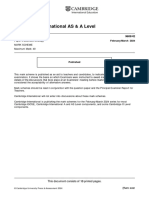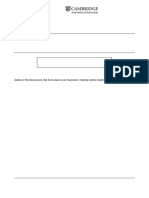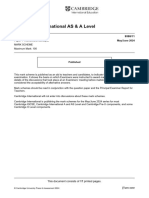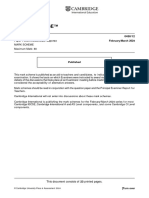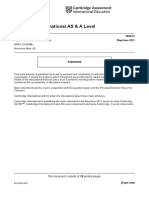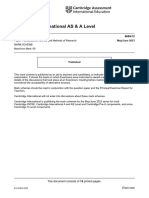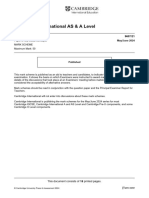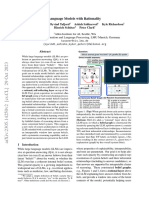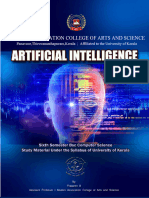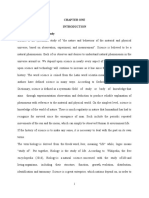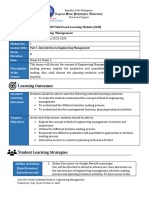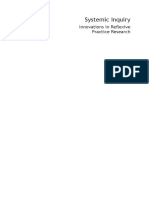Cambridge International AS & A Level: Business 9609/32
Cambridge International AS & A Level: Business 9609/32
Uploaded by
sannusyed.2007Copyright:
Available Formats
Cambridge International AS & A Level: Business 9609/32
Cambridge International AS & A Level: Business 9609/32
Uploaded by
sannusyed.2007Original Title
Copyright
Available Formats
Share this document
Did you find this document useful?
Is this content inappropriate?
Copyright:
Available Formats
Cambridge International AS & A Level: Business 9609/32
Cambridge International AS & A Level: Business 9609/32
Uploaded by
sannusyed.2007Copyright:
Available Formats
Cambridge International AS & A Level
BUSINESS 9609/32
Paper 3 Business Decision-making May/June 2024
MARK SCHEME
Maximum Mark: 60
Published
This mark scheme is published as an aid to teachers and candidates, to indicate the requirements of the
examination. It shows the basis on which Examiners were instructed to award marks. It does not indicate the
details of the discussions that took place at an Examiners’ meeting before marking began, which would have
considered the acceptability of alternative answers.
Mark schemes should be read in conjunction with the question paper and the Principal Examiner Report for
Teachers.
Cambridge International will not enter into discussions about these mark schemes.
Cambridge International is publishing the mark schemes for the May/June 2024 series for most
Cambridge IGCSE, Cambridge International A and AS Level and Cambridge Pre-U components, and some
Cambridge O Level components.
This document consists of 24 printed pages.
© Cambridge University Press & Assessment 2024 [Turn over
9609/32 Cambridge International AS & A Level – Mark Scheme May/June 2024
PUBLISHED
Generic Marking Principles
These general marking principles must be applied by all examiners when marking candidate answers. They should be applied alongside the
specific content of the mark scheme or generic level descriptions for a question. Each question paper and mark scheme will also comply with these
marking principles.
GENERIC MARKING PRINCIPLE 1:
Marks must be awarded in line with:
the specific content of the mark scheme or the generic level descriptors for the question
the specific skills defined in the mark scheme or in the generic level descriptors for the question
the standard of response required by a candidate as exemplified by the standardisation scripts.
GENERIC MARKING PRINCIPLE 2:
Marks awarded are always whole marks (not half marks, or other fractions).
GENERIC MARKING PRINCIPLE 3:
Marks must be awarded positively:
marks are awarded for correct/valid answers, as defined in the mark scheme. However, credit is given for valid answers which go beyond
the scope of the syllabus and mark scheme, referring to your Team Leader as appropriate
marks are awarded when candidates clearly demonstrate what they know and can do
marks are not deducted for errors
marks are not deducted for omissions
answers should only be judged on the quality of spelling, punctuation and grammar when these features are specifically assessed by the
question as indicated by the mark scheme. The meaning, however, should be unambiguous.
GENERIC MARKING PRINCIPLE 4:
Rules must be applied consistently, e.g. in situations where candidates have not followed instructions or in the application of generic level
descriptors.
© Cambridge University Press & Assessment 2024 Page 2 of 24
9609/32 Cambridge International AS & A Level – Mark Scheme May/June 2024
PUBLISHED
GENERIC MARKING PRINCIPLE 5:
Marks should be awarded using the full range of marks defined in the mark scheme for the question (however; the use of the full mark range may
be limited according to the quality of the candidate responses seen).
GENERIC MARKING PRINCIPLE 6:
Marks awarded are based solely on the requirements as defined in the mark scheme. Marks should not be awarded with grade thresholds or
grade descriptors in mind.
© Cambridge University Press & Assessment 2024 Page 3 of 24
9609/32 Cambridge International AS & A Level – Mark Scheme May/June 2024
PUBLISHED
Social Science-Specific Marking Principles
(for point-based marking)
1 Components using point-based marking:
Point marking is often used to reward knowledge, understanding and application of skills. We give credit where the candidate’s answer
shows relevant knowledge, understanding and application of skills in answering the question. We do not give credit where the answer
shows confusion.
From this it follows that we:
a DO credit answers which are worded differently from the mark scheme if they clearly convey the same meaning (unless the mark
scheme requires a specific term)
b DO credit alternative answers/examples which are not written in the mark scheme if they are correct
c DO credit answers where candidates give more than one correct answer in one prompt/numbered/scaffolded space where extended
writing is required rather than list-type answers. For example, questions that require n reasons (e.g. State two reasons …).
d DO NOT credit answers simply for using a ‘key term’ unless that is all that is required. (Check for evidence it is understood and not used
wrongly.)
e DO NOT credit answers which are obviously self-contradicting or trying to cover all possibilities
f DO NOT give further credit for what is effectively repetition of a correct point already credited unless the language itself is being tested.
This applies equally to ‘mirror statements’ (i.e. polluted/not polluted).
g DO NOT require spellings to be correct, unless this is part of the test. However spellings of syllabus terms must allow for clear and
unambiguous separation from other syllabus terms with which they may be confused (e.g. Corrasion/Corrosion).
2 Presentation of mark scheme:
Slashes (/) or the word ‘or’ separate alternative ways of making the same point.
Semi colons (;) bullet points (•) or figures in brackets (1) separate different points.
Content in the answer column in brackets is for examiner information/context to clarify the marking but is not required to earn the mark
(except Accounting syllabuses where they indicate negative numbers).
© Cambridge University Press & Assessment 2024 Page 4 of 24
9609/32 Cambridge International AS & A Level – Mark Scheme May/June 2024
PUBLISHED
3 Calculation questions:
The mark scheme will show the steps in the most likely correct method(s), the mark for each step, the correct answer(s) and the mark
for each answer.
If working/explanation is considered essential for full credit, this will be indicated in the question paper and in the mark scheme. In all
other instances, the correct answer to a calculation should be given full credit, even if no supporting working is shown.
Where the candidate uses a valid method which is not covered by the mark scheme, award equivalent marks for reaching equivalent
stages.
Where an answer makes use of a candidate’s own incorrect figure from previous working, the ‘own figure rule’ applies: full marks will be
given if a correct and complete method is used. Further guidance will be included in the mark scheme where necessary and any
exceptions to this general principle will be noted.
4 Annotation:
For point marking, ticks can be used to indicate correct answers and crosses can be used to indicate wrong answers. There is no direct
relationship between ticks and marks. Ticks have no defined meaning for levels of response marking.
For levels of response marking, the level awarded should be annotated on the script.
Other annotations will be used by examiners as agreed during standardisation, and the meaning will be understood by all examiners
who marked that paper.
© Cambridge University Press & Assessment 2024 Page 5 of 24
9609/32 Cambridge International AS & A Level – Mark Scheme May/June 2024
PUBLISHED
Guidance on using levels-based marking
Marking of work should be positive, rewarding achievement where possible, but clearly differentiating across the whole range of marks, where
appropriate.
The examiner should look at the work and then make a judgement about which level statement is the best fit. In practice, work does not always
match one level statement precisely so a judgement may need to be made between two or more level statements.
Once a best-fit level statement has been identified, use the following guidance to decide on a specific mark:
If the candidate’s work convincingly meets the level statement, award the highest mark.
If the candidate’s work adequately meets the level statement, award the most appropriate mark in the middle of the range.
If the candidate’s work just meets the level statement, award the lowest mark.
L1, L2 etc. must be clearly annotated on the response at the point where the level is achieved.
Assessment objectives
AO1 Knowledge and understanding
Demonstrate knowledge and understanding of business concepts, terms and theories.
AO2 Application
Apply knowledge and understanding of business concepts, terms and theories to problems and issues in a variety of familiar and unfamiliar
business situations and contexts.
AO3 Analysis
Analyse business problems, issues and situations by:
using appropriate methods and techniques to make sense of qualitative and quantitative business information
searching for causes, impact and consequences
distinguishing between factual evidence and opinion or value judgement
drawing valid inferences and making valid generalisations
AO4 Evaluation
Evaluate evidence in order to make reasoned judgements, present substantiated conclusions and, where appropriate, make recommendations for
action and implementation.
© Cambridge University Press & Assessment 2024 Page 6 of 24
9609/32 Cambridge International AS & A Level – Mark Scheme May/June 2024
PUBLISHED
Question Answer Marks
1 Analyse two advantages to SF of using flexible employment contracts. 8
Level AO1 Knowledge and AO2 Application AO3 Analysis
understanding 2 marks 4 marks
2 marks
2 3–4 marks
Developed analysis
Developed analysis that
identifies connections between
causes, impacts and/or
consequences of two points.
Developed analysis that
identifies connections between
causes, impacts and/or
consequences of one point.
1 1–2 marks 1–2 marks 1–2 marks
Knowledge of two relevant Application of two relevant Limited analysis
points is used to answer the points to a business context. Limited analysis that identifies
question. Application of one relevant connections between causes,
Knowledge of one relevant point to a business context. impacts and/or consequences
point is used to answer the of two points.
question. Limited analysis that identifies
connections between causes,
impacts and/or consequences
of one point.
0 0 marks 0 marks 0 marks
No creditable response. No creditable response. No creditable response.
© Cambridge University Press & Assessment 2024 Page 7 of 24
9609/32 Cambridge International AS & A Level – Mark Scheme May/June 2024
PUBLISHED
Question Answer Marks
1 Note:
Only reward advantages.
If more than two advantages are referred to, reward the best two.
L2AN (3 marks) is possible for just one point made.
All annotation ( ) should be in the left margin.
Indicative content
AO1 Knowledge and understanding
Definition of relevant terms (max K 1 mark)
Flexible contracts include making use of temporary, part-time and zero-hour contracts rather than permanent full-time
contracts.
– Temporary contracts offered for fixed period.
– Part-time contracts; employees contracted to work for less hours than full-time.
– Zero-hour contracts; no guaranteed minimum number of hours.
– It can allow employees to work at home/pick the hours they work.
Knowledge of benefits (max K 2 marks)
Benefits include:
– Can reduce fixed costs.
– Adjusting labour costs flexibly.
– More employees available to cover sickness.
– SF can check efficiency of employees before offering full-time contracts.
– Motivating for employees because can pick their own hours/allows employees to work at home.
AO2 Application
Limited application, applies knowledge to SF once.
Developed application, + applies knowledge to SF twice.
Max one for application for the first advantage and max one for application for the second advantage.
Seasonal nature of farming. At harvest time more demand for labour on the farms to harvest crops.
Competitive markets that SF operates in.
There is seasonal demand for Sosoy Ice Cream so there is a need to vary production.
SF employs peripheral employees on temporary or zero-hour contracts linked to seasonal production.
© Cambridge University Press & Assessment 2024 Page 8 of 24
9609/32 Cambridge International AS & A Level – Mark Scheme May/June 2024
PUBLISHED
Question Answer Marks
1 AO3 Analysis
Limited analysis – candidate shows one link in the chain of analysis.
Developed analysis – candidate shows two or more links in the chain of analysis.
Temporary contracts enable SF to respond flexibly to changing labour needs over time reducing costs for the business
.
Reducing costs will enable SF to set competitive prices which can attract customers and therefore increase market
share .
SF will be able to call in workers when needed if other employees are sick or on maternity leave thus ensuring that
production is not disrupted .
Zero-hour contracts enables SF to increase production quickly in response to unexpected changes in demand meeting
customer needs more efficiently and boosting sales which may result in an increase in profit .
Motivating for employees because they can pick their own hours/allow employees to work at home this would lead to
lower employee turnover which would reduce costs for SF.
Accept all valid responses.
© Cambridge University Press & Assessment 2024 Page 9 of 24
9609/32 Cambridge International AS & A Level – Mark Scheme May/June 2024
PUBLISHED
Question Answer Marks
2 Analyse two problems SF may experience when implementing total quality management (TQM). 8
Level AO1 Knowledge and AO2 Application AO3 Analysis
understanding 2 marks 4 marks
2 marks
2 3–4 marks
Developed analysis
Developed analysis that
identifies connections between
causes, impacts and/or
consequences of two points.
Developed analysis that
identifies connections between
causes, impacts and/or
consequences of one point.
1 1–2 marks 1–2 marks 1–2 marks
Knowledge of two relevant Application of two relevant Limited analysis
points is used to answer the points to a business context. Limited analysis that identifies
question. Application of one relevant connections between causes,
Knowledge of one relevant point to a business context. impacts and/or consequences
point is used to answer the of two points.
question. Limited analysis that identifies
connections between causes,
impacts and/or consequences
of one point.
0 0 marks 0 marks 0 marks
No creditable response. No creditable response. No creditable response.
© Cambridge University Press & Assessment 2024 Page 10 of 24
9609/32 Cambridge International AS & A Level – Mark Scheme May/June 2024
PUBLISHED
Question Answer Marks
2 Note:
Only reward problems/disadvantages.
If more than two problems are referred to, reward the best two.
L2AN (3 marks) is possible for just one point made.
All annotation ( ) should be in the left margin.
Indicative content
AO1 Knowledge and understanding
Definition of relevant terms (max K 1 mark)
TQM is a method of quality assurance that aims to involve all employees in quality improvements.
Encourages workers to get it right first time and to achieve zero defects.
Knowledge of problems when implementing TQM (max K 2 marks)
Problems may include:
– Cost of training for employees.
– Resistance from employees.
– Short term negative impacts on productivity and or quality as changes are embedded.
– Lack of managerial skills of motivation, delegation of decision making, teamwork, communication and coordination.
– Requires a change in culture within the business.
– Impact of making quality inspectors redundant.
– Time consuming – with a reason e.g. training staff, changing culture, change policies, employees checking work.
– Nature of the product – TQM on ice cream – how to implement quality checks?
AO2 Application
Limited application, applies knowledge to SF once.
Developed application, + applies knowledge to SF twice.
Max one for application for the first problem and max one for application for the second problem.
SF’s use of flexible contracts including part-time, temporary and zero-hours.
Temporary workers employed at harvest time for short period.
Current approach focuses on detection of quality problems rather than prevention.
Factory operating close to capacity.
Limited training given to peripheral employees.
Unskilled workers – more training required.
© Cambridge University Press & Assessment 2024 Page 11 of 24
9609/32 Cambridge International AS & A Level – Mark Scheme May/June 2024
PUBLISHED
Question Answer Marks
2 AO3 Analysis
Limited analysis – candidate shows one link in the chain of analysis.
Developed analysis – candidate shows two or more links in the chain of analysis.
Difficult to change culture of business as many employees are on flexible contracts and may therefore lack commitment
to the business .
Cost of training will be relatively high as workers on temporary contracts not in the business for long. Each new group
of temporary workers at harvest time each year will need training, increasing costs .
No need for quality inspectors so may need to make redundancies adding to costs of implementation and causing
concerns over job security which could reduce productivity .
In short-term may result in increase in defective products as adjusting to TQM approach takes time. This could result in
short-term customer dissatisfaction and impact sales negatively and therefore reducing profit .
Accept all valid responses.
© Cambridge University Press & Assessment 2024 Page 12 of 24
9609/32 Cambridge International AS & A Level – Mark Scheme May/June 2024
PUBLISHED
Question Answer Marks
3(a) Refer to Table 1.1. Calculate for quarter 1, 2023, the seasonal variation. 1
Seasonal variation = 16 – 23.75 = – 7.75 OR – 7750 OR (7.75) (1)
Note:
No mark for 7.75 OR 7750.
3(b) Refer to Table 1.1. Calculate for quarter 2, 2023, the centred quarterly moving average. 3
Note Answer Mark
Correct answer 25 OR 25 000 3
Correct method but no correct final answer 98+102 = 200 2
OR OR
Calculation of 8 period moving total 98 000 + 102 000 = 200 000
OR
200 / 8 OR 200 000 / 8
Note: 200 OR 200 000 written on its own is 0 marks
Accurate method must be shown
Calculation of one or more correct 4 period 20 + 16 + 27 + 35 = 98 OR/AND 16 + 27 + 35 + 24 = 102 1
moving totals OR
4 period MA = 8 period moving total / 8
OR OR
102 / 4 = 25.5
Knowledge of correct method
Zero marks No creditable response 0
For example, just provides incorrect 4 period moving total
For anything other than the full mark answer there should be relevant working.
© Cambridge University Press & Assessment 2024 Page 13 of 24
9609/32 Cambridge International AS & A Level – Mark Scheme May/June 2024
PUBLISHED
Question Answer Marks
3(c) Evaluate the usefulness to SF of sales forecasting. 12
Level AO1 Knowledge and AO2 Application AO3 Analysis AO4 Evaluation
understanding 2 marks 2 marks 6 marks
2 marks
3 5–6 marks
Developed evaluation in
context
A developed
judgement/conclusion is
made in the business context.
Developed evaluative
comments which balance
some key arguments in the
business context.
2 2 marks 2 marks 2 marks 3–4 marks
Developed knowledge Developed application Developed analysis Developed evaluation
of relevant key term(s) of relevant point(s) to that identifies A developed
and/or factor(s) is used the business context. connections judgement/conclusion is
to answer the question. between causes, made.
impacts and/or Developed evaluative
consequences. comments which balance
some key arguments.
1 1 mark 1 mark 1 mark 1–2 marks
Limited knowledge Limited application Limited analysis Limited evaluation
of relevant key term(s) of relevant point(s) to that identifies A judgement/conclusion is
and/or factor(s) is used the business context. connections made with limited supporting
to answer the question. between causes, comment/evidence.
impacts and/or An attempt is made to
consequences. balance the arguments.
© Cambridge University Press & Assessment 2024 Page 14 of 24
9609/32 Cambridge International AS & A Level – Mark Scheme May/June 2024
PUBLISHED
Question Answer Marks
3(c)
0 0 marks 0 marks 0 marks 0 marks
No creditable response. No creditable response. No creditable No creditable response.
response.
All annotation ( ) should be in the left margin.
Indicative content
AO1 Knowledge and understanding
Limited knowledge will be demonstrated through knowledge of sales forecasting or knowledge of the usefulness or
limitations of sales forecasting to SF.
Developed knowledge + will be demonstrated through knowledge of sales forecasting and knowledge of the
usefulness or limitations of sales forecasting to SF.
Sales forecasting involves making a prediction of future sales.
Time series analysis is a method of forecasting based on extrapolation from past data.
Benefits of sales forecasting include:
– Contribution to workforce planning
– Planning purchase of resources
– Greater accuracy in cash flow forecasting
– Aids operational decisions such as need to increase capacity
– Aids decisions about pricing
Drawbacks of sales forecasting include:
– Inaccuracy
– Dynamic market
– Doesn’t take into account qualitative factors
– Past can’t predict the future
– Moving averages are based on past data
AO2 Application
Limited application, applies knowledge to SF once.
Developed application, + applies knowledge to SF twice.
Reference to current capacity utilisation of over 90%.
Need for forecast of sales if start to export to country D.
Role of market reports and market research in forecasting.
© Cambridge University Press & Assessment 2024 Page 15 of 24
9609/32 Cambridge International AS & A Level – Mark Scheme May/June 2024
PUBLISHED
Question Answer Marks
3(c) Identifying likely demand for tofu and Sosoy Ice Cream.
Identifying employees needed in factory and decision about employment contracts to use.
Inability to control the weather.
AO3 Analysis
Limited analysis – candidate shows one link in the chain of analysis.
Developed analysis – candidate shows two or more links in the chain of analysis.
Helps ensure efficient use of labour and machinery helping to control costs of production and therefore increase
profit .
Contributes to creating cash flow forecast which will help ensure that SF has sufficient finance in place to deal with
future needs .
Sales forecasts for entering country D will help evaluate whether break-even can be achieved and therefore
whether exports are likely to be successful .
Because the market is dynamic it could lead to misallocation of resources such as having too many peripheral
employees in the factory which would lead to increased costs .
AO4 Evaluation
Limited evaluation – limited supported judgement and/or a weak attempt at evaluative comment.
Developed evaluation – supported judgement and/or reasonable evaluative comment.
Developed evaluation in context – supported judgement in context and/or reasonable evaluative comment in
context.
Using 4 period moving average fits the data well as there are clear seasonal variations ensuring that the technique is
more likely to give reliable results.
Unexpected changes in the external environment such as entry of a new competitor will result in the predictions being
incorrect and therefore less useful in making the best decisions.
TSA relies on future events behaving as in the past so may not be reliable as markets are dynamic.
May be advisable to introduce an element of probability to the forecasts – what if analysis?
The longer the time frame the less useful the forecast is because there are more likely to be external events that impact
the forecast.
Using simple moving averages and a line of best fit may be too simplistic.
Usefulness is limited if managers don’t use the sales forecast to make decisions.
Should be used in conjunction with qualitative data and current market data to improve usefulness.
Accept all valid responses.
© Cambridge University Press & Assessment 2024 Page 16 of 24
9609/32 Cambridge International AS & A Level – Mark Scheme May/June 2024
PUBLISHED
Question Answer Marks
4(a) Refer to Table 1.2. Calculate the accounting rate of return (ARR) of automating production. 4
Note Answer Mark
Calculation of ARR 0.4 / 1.75 100 = 22.86(%) OR 22.9 OR 23 4
Working and % not required
Correct rounding must be applied
Calculation of average profit 0.4 OR $0.4 m 3
and and
average investment 1.75 OR $1.75 m
OR
An incorrect answer with one mistake 0.9 / 1.75 x 100 = 51.43%
allowing OFR for final stage
Not subtracted capital cost e.g. 22.83
OR
Incorrect rounding 0.4 / 1.25 100 = 32%
OR
Subtracted residual value rather than
adding (OFR)
Calculation of average profit 2.4 / 6 = 0.4 OR $0.4 m 2
OR
Calculation of profit and average $2.4m AND $1.75 m
investment
OR $2.4m AND ARR = Average profit / average investment X
Calculation of profit and statement of 100
ARR equation
OR $1.75m AND ARR = Average profit / average investment
Calculation of average investment 100
and statement of ARR equation
OR 0.9 AND AND ARR = Average profit / average investment
0.9 and statement of ARR equation 100
© Cambridge University Press & Assessment 2024 Page 17 of 24
9609/32 Cambridge International AS & A Level – Mark Scheme May/June 2024
PUBLISHED
Question Answer Marks
4(a)
Note Answer Mark
Calculation of profit (0.3 + 0.5 + 0.8 + 1.0 + 1.1 + 1.7) – 3.0 = 2.4 OR $2.4 m 1
OR (3.0 + 0.5) / 2 = 1.75 OR $1.75 m
Calculation of average investment
OR ARR = Average profit / average investment 100
ARR equation
OR 5.4 / 6 = 0.9
Attempt to calculate mean yearly
profit without deducting capital cost
Zero marks No creditable content 0
Note: No mark for non-syllabus equation: Average profit/capital cost 100
© Cambridge University Press & Assessment 2024 Page 18 of 24
9609/32 Cambridge International AS & A Level – Mark Scheme May/June 2024
PUBLISHED
Question Answer Marks
4(b) Evaluate whether SF should invest in automating production. 12
Level AO1 Knowledge and AO2 Application AO3 Analysis AO4 Evaluation
understanding 2 marks 2 marks 6 marks
2 marks
3 5–6 marks
Developed evaluation in
context
A developed
judgement/conclusion is
made in the business context.
Developed evaluative
comments which balance
some key arguments in the
business context.
2 2 marks 2 marks 2 marks 3–4 marks
Developed knowledge Developed application Developed analysis Developed evaluation
of relevant key term(s) of relevant point(s) to that identifies A developed
and/or factor(s) is used the business context. connections judgement/conclusion is
to answer the question. between causes, made.
impacts and/or Developed evaluative
consequences. comments which balance
some key arguments.
1 1 mark 1 mark 1 mark 1–2 marks
Limited knowledge Limited application Limited analysis Limited evaluation
of relevant key term(s) of relevant point(s) to that identifies A judgement/conclusion is
and/or factor(s) is used the business context. connections made with limited supporting
to answer the question. between causes, comment/evidence.
impacts and/or An attempt is made to
consequences. balance the arguments.
© Cambridge University Press & Assessment 2024 Page 19 of 24
9609/32 Cambridge International AS & A Level – Mark Scheme May/June 2024
PUBLISHED
Question Answer Marks
4(b)
0 0 marks 0 marks 0 marks 0 marks
No creditable response. No creditable response. No creditable No creditable response.
response.
Indicative content
AO1 Knowledge and understanding
Limited knowledge will be demonstrated through knowledge of one factor in the decision.
Developed knowledge + will be demonstrated through knowledge of two or more factors in the decision.
Automation will reduce the relative number of employees.
Other factors in decision:
– Cost
– Availability of finance
– Impact on employees
– ARR
– Payback results and NPV
– Control over quality
– Benefits/limitations of alternatives such as outsourcing
– Production may/should increase
– Less mistakes made
AO2 Application
Limited application, applies knowledge to SF once.
Developed application, + applies knowledge to SF twice.
Use of results to investment appraisal OFR/case study information.
ARR is above criterion rate of 20%.
Payback is 4 years and 4 months (4.36 years). Allow within 5 years. Allow 132.7 days.
Sales forecast data shows clear upward sales trend of ice cream.
Capacity utilisation is 90%.
Plans to export to country D.
Possible impact of joining free trade area.
© Cambridge University Press & Assessment 2024 Page 20 of 24
9609/32 Cambridge International AS & A Level – Mark Scheme May/June 2024
PUBLISHED
Question Answer Marks
4(b) AO3 Analysis
Limited analysis – candidate shows one link in the chain of analysis.
Developed analysis – candidate shows two or more links in the chain of analysis.
Reduction in number of employees will reduce unit labour costs of production . This will help reduce unit costs and
could result in a higher profit margin or a lower selling price leading to increased sales .
Outsourcing could reduce control over quality and increase chance of poor-quality food reaching customers and
consumers resulting in dissatisfaction and therefore a loss of sales .
Joining free trade area in January 2025 may lead to increased exports increasing pressure on capacity therefore
SF need to increase capacity to meet expected demand .
The capital investment cost required for automating would mean sacrificing alternative investment decisions .
AO4 Evaluation
Limited evaluation – limited supported judgement and/or a weak attempt at evaluative comment.
Developed evaluation – supported judgement and/or reasonable evaluative comment.
Developed evaluation in context – supported judgement in context and/or reasonable evaluative comment in
context.
Elements that the evaluation/judgement might depend on:
– Accuracy of the data over 6 years.
– Significance of retaining control over quality for food products.
– Depends on whether the increase in demand is long-term.
– Reaction of employees and consideration of duty to them.
– Availability of finance.
– How long will it take to implement?
– Impact on quality.
– Availability of appropriately trained/skilled labour.
Accept all valid responses.
© Cambridge University Press & Assessment 2024 Page 21 of 24
9609/32 Cambridge International AS & A Level – Mark Scheme May/June 2024
PUBLISHED
Question Answer Marks
5 Evaluate the impact on SF of country B becoming a member of the NFTA international trading agreement. 12
Level AO1 Knowledge and AO2 Application AO3 Analysis AO4 Evaluation
understanding 2 marks 2 marks 6 marks
2 marks
3 5–6 marks
Developed evaluation in
context
A developed
judgement/conclusion is
made in the business context.
Developed evaluative
comments which balance
some key arguments in the
business context.
2 2 marks 2 marks 2 marks 3–4 marks
Developed knowledge Developed application Developed analysis Developed evaluation
of relevant key term(s) of relevant point(s) to that identifies A developed
and/or factor(s) is used the business context. connections judgement/conclusion is
to answer the question. between causes, made.
impacts and/or Developed evaluative
consequences. comments which balance
some key arguments.
1 1 mark 1 mark 1 mark 1–2 marks
Limited knowledge Limited application Limited analysis Limited evaluation
of relevant key term(s) of relevant point(s) to that identifies A judgement/conclusion is
and/or factor(s) is used the business context. connections made with limited supporting
to answer the question. between causes, comment/evidence.
impacts and/or An attempt is made to
consequences. balance the arguments.
© Cambridge University Press & Assessment 2024 Page 22 of 24
9609/32 Cambridge International AS & A Level – Mark Scheme May/June 2024
PUBLISHED
Question Answer Marks
5
0 0 marks 0 marks 0 marks 0 marks
No creditable response. No creditable response. No creditable No creditable response.
response.
Indicative content
AO1 Knowledge and understanding
Limited knowledge will be demonstrated through knowledge of international trading agreements or knowledge of how
the international trading agreement could impact SF.
Developed knowledge + will be demonstrated through knowledge of international trading agreements and
knowledge of how the international trading agreement could impact SF.
Free trade area removes tariffs and quotas between member states but allows country B to set tariffs against non-
member states.
Reduce cost of trading between countries.
Increased competition.
Reduce import costs.
Increased potential ability to export products.
AO2 Application
Limited application, applies knowledge to SF once.
Developed application, + applies knowledge to SF twice.
Reduce cost of fertiliser imports from country D.
A member of the NFTA is one of the largest producers of soya in the world.
High income of NFTA member states.
Membership will facilitate exports of Sosoy Ice Cream.
Country B currently has tariffs on agricultural commodities and processed food products.
SF’s manufactured products are likely to be income elastic.
© Cambridge University Press & Assessment 2024 Page 23 of 24
9609/32 Cambridge International AS & A Level – Mark Scheme May/June 2024
PUBLISHED
Question Answer Marks
5 AO3 Analysis
Limited analysis – candidate shows one link in the chain of analysis.
Developed analysis – candidate shows two or more links in the chain of analysis.
Removal of tariffs will reduce the cost of importing fertiliser and therefore reduce the costs of producing soya and maize
. Therefore, potential increase in profit margins or can reduce prices to increase sales .
Free trade will increase competition from member states of NFTA which may result in lower sales for SF and
reduce revenue and profit .
Increase in consumer incomes due to free trade will increase demand for food products that SF sells .
As member states are high income countries free trade should enable SF to take advantage of likely demand for its
food products and can increase exports .
AO4 Evaluation
Limited evaluation – limited supported judgement and/or a weak attempt at evaluative comment.
Developed evaluation – supported judgement and/or reasonable evaluative comment.
Developed evaluation in context – supported judgement in context and/or reasonable evaluative comment in
context.
Elements that the evaluation/judgement might depend on:
– Impact on costs depends on proportion of imported inputs used in the production process.
– Increased competition in the soya market likely to have significant impact as the product is undifferentiated so SF
will have to reduce the price of its soya beans sold to manufacturers of soymeal and soy oil.
– Export success of SF manufactured foods will depend on brand loyalty that exists in country D and other member
states.
Supported identification of most important factor or consequence.
Accept all valid responses.
© Cambridge University Press & Assessment 2024 Page 24 of 24
You might also like
- Secrets of Cold War TechnologyDocument162 pagesSecrets of Cold War TechnologyMuhammad Akhavan100% (1)
- Philosophy of Education Comprehensive ReportDocument13 pagesPhilosophy of Education Comprehensive ReportJerric AbreraNo ratings yet
- What Is An Educated FilipinoDocument2 pagesWhat Is An Educated Filipinokheymi78% (9)
- 9609_s24_ms_23Document29 pages9609_s24_ms_23Jessica HANNo ratings yet
- Cambridge International AS & A Level: Business 9609/31Document25 pagesCambridge International AS & A Level: Business 9609/31sannusyed.2007No ratings yet
- 9609_s24_ms_42Document16 pages9609_s24_ms_42Dio HanNo ratings yet
- Cambridge International AS & A Level: Business 9609/22Document30 pagesCambridge International AS & A Level: Business 9609/22BusEco TutorNo ratings yet
- Cambridge International AS & A Level: Business 9609/42Document13 pagesCambridge International AS & A Level: Business 9609/42smitha5vinodNo ratings yet
- Cambridge International AS & A Level: Business 9609/32Document22 pagesCambridge International AS & A Level: Business 9609/32BusEco TutorNo ratings yet
- Cambridge International AS & A Level: Business 9609/12Document27 pagesCambridge International AS & A Level: Business 9609/12BusEco TutorNo ratings yet
- 9609_s24_ms_13Document34 pages9609_s24_ms_13mahnoorhaider.238No ratings yet
- Cambridge International AS & A Level: Accounting 9706/32Document19 pagesCambridge International AS & A Level: Accounting 9706/32eco2dayNo ratings yet
- 7100_s24_ms_22Document25 pages7100_s24_ms_22spjasmine202pNo ratings yet
- 9084_s24_ms_21Document17 pages9084_s24_ms_21inyNo ratings yet
- Cambridge International AS & A Level: Accounting 9706/22Document16 pagesCambridge International AS & A Level: Accounting 9706/22Zaynab RoheemunNo ratings yet
- Cambridge International AS & A Level: Business 9609/32Document24 pagesCambridge International AS & A Level: Business 9609/32Fatema NawrinNo ratings yet
- Cambridge International AS & A Level: BusinessDocument24 pagesCambridge International AS & A Level: BusinessNipuni PereraNo ratings yet
- Cambridge International AS & A Level: Business 9609/32 May/June 2022Document25 pagesCambridge International AS & A Level: Business 9609/32 May/June 2022btsfan2002007No ratings yet
- Cambridge International AS & A Level: Business 9609/21 May/June 2022Document22 pagesCambridge International AS & A Level: Business 9609/21 May/June 2022cx9tc54hjvNo ratings yet
- Cambridge International AS & A Level: Business 9609/23 May/June 2022Document17 pagesCambridge International AS & A Level: Business 9609/23 May/June 2022Ss EditzNo ratings yet
- Cambridge International AS & A Level: Business 9609/12 May/June 2022Document20 pagesCambridge International AS & A Level: Business 9609/12 May/June 2022fopabip33No ratings yet
- Cambridge International AS & A Level: Business 9609/41Document16 pagesCambridge International AS & A Level: Business 9609/41Arnold VasheNo ratings yet
- Cambridge International AS & A Level: Economics 9708/41Document11 pagesCambridge International AS & A Level: Economics 9708/41pigak65596No ratings yet
- Cambridge International AS & A Level: Business 9609/42Document18 pagesCambridge International AS & A Level: Business 9609/42Harris SusantoNo ratings yet
- Cambridge International AS & A Level: Business 9609/12Document32 pagesCambridge International AS & A Level: Business 9609/12Teresa ChiranNo ratings yet
- Cambridge International AS & A Level: Business 9609/11 May/June 2022Document18 pagesCambridge International AS & A Level: Business 9609/11 May/June 2022Tawanda BlackwatchNo ratings yet
- Cambridge International AS & A Level: Business 9609/13 May/June 2022Document18 pagesCambridge International AS & A Level: Business 9609/13 May/June 2022Rinnah TeklayNo ratings yet
- Cambridge International AS & A Level: Business 9609/11Document32 pagesCambridge International AS & A Level: Business 9609/11Mumba HopeNo ratings yet
- Cambridge International AS & A Level: Business 9609/21Document35 pagesCambridge International AS & A Level: Business 9609/21Maitaishe Gora100% (1)
- Bus P1Document105 pagesBus P1saharnoor996No ratings yet
- Cambridge International AS & A Level: Economics 9708/42Document15 pagesCambridge International AS & A Level: Economics 9708/42pigak65596No ratings yet
- Cambridge International AS & A Level: Business 9609/32Document24 pagesCambridge International AS & A Level: Business 9609/32sadia asimNo ratings yet
- Travel Past PaperDocument23 pagesTravel Past Paperruggiet87No ratings yet
- Cambridge International AS & A Level: Business 9609/13Document32 pagesCambridge International AS & A Level: Business 9609/13mrunmayilonkarNo ratings yet
- Cambridge O Level: Global Perspectives 2069/02Document8 pagesCambridge O Level: Global Perspectives 2069/02hafak27227No ratings yet
- Cambridge International AS & A Level: Business 9609/13 October/November 2022Document19 pagesCambridge International AS & A Level: Business 9609/13 October/November 2022Sasa DzudzevicNo ratings yet
- Cambridge International AS & A Level: Business 9609/32 May/June 2021Document24 pagesCambridge International AS & A Level: Business 9609/32 May/June 2021StarboyNo ratings yet
- 9609 m22 Ms 12 PDFDocument18 pages9609 m22 Ms 12 PDFthabo bhejaneNo ratings yet
- Cambridge International AS & A Level: EconomicsDocument19 pagesCambridge International AS & A Level: Economicscloriszhang521No ratings yet
- Cambridge International AS & A Level: Sociology 9699/31 May/June 2022Document13 pagesCambridge International AS & A Level: Sociology 9699/31 May/June 2022Trang MinhNo ratings yet
- 9395_s24_ms_11Document17 pages9395_s24_ms_11lioteteamNo ratings yet
- 9699_s24_ms_13Document17 pages9699_s24_ms_13usman443178No ratings yet
- Cambridge International AS & A Level: Sociology 9699/22 May/June 2022Document17 pagesCambridge International AS & A Level: Sociology 9699/22 May/June 2022nicolechinemaNo ratings yet
- Cambridge International AS & A Level: Business 9609/42Document19 pagesCambridge International AS & A Level: Business 9609/42sadia asimNo ratings yet
- 9699_s24_ms_42Document19 pages9699_s24_ms_42usman443178No ratings yet
- 9699_s24_ms_11Document19 pages9699_s24_ms_11saleemifrah599No ratings yet
- Cambridge IGCSE ™: Business Studies 0450/12Document23 pagesCambridge IGCSE ™: Business Studies 0450/12AHMADNo ratings yet
- Cambridge International AS & A Level: Sociology 9699/11 May/June 2022Document17 pagesCambridge International AS & A Level: Sociology 9699/11 May/June 2022katsandeNo ratings yet
- Cambridge O Level: Economics 2281/21Document24 pagesCambridge O Level: Economics 2281/21Muhammad MustansirNo ratings yet
- Cambridge International AS & A Level: Business 9609/21Document31 pagesCambridge International AS & A Level: Business 9609/21691922029No ratings yet
- Cambridge International AS & A Level: Business 9609/41Document12 pagesCambridge International AS & A Level: Business 9609/41Ishtee RughooburNo ratings yet
- Cambridge International AS & A Level: Business 9609/32 February/March 2022Document23 pagesCambridge International AS & A Level: Business 9609/32 February/March 2022thabo bhejaneNo ratings yet
- Cambridge International AS & A Level: Business 9609/12 May/June 2021Document19 pagesCambridge International AS & A Level: Business 9609/12 May/June 2021RizwanSial100% (1)
- Cambridge International AS & A Level: Sociology 9699/12Document15 pagesCambridge International AS & A Level: Sociology 9699/12Rida ShariqNo ratings yet
- Cambridge International AS & A Level: Media Studies 9607/21Document18 pagesCambridge International AS & A Level: Media Studies 9607/21Ansh YaduvanshiNo ratings yet
- Cambridge International AS & A Level: Business 9609/22Document38 pagesCambridge International AS & A Level: Business 9609/22sadafayub33No ratings yet
- Cambridge International AS & A Level: Economics 9708/22 October/November 2022Document17 pagesCambridge International AS & A Level: Economics 9708/22 October/November 2022kutsofatsoNo ratings yet
- Cambridge International AS & A Level: SociologyDocument19 pagesCambridge International AS & A Level: Sociologykinggatete2005No ratings yet
- Cambridge International AS & A Level: Sociology 9699/32Document10 pagesCambridge International AS & A Level: Sociology 9699/32Tomisin KoladeNo ratings yet
- Cambridge International AS & A Level: Sociology 9699/32Document12 pagesCambridge International AS & A Level: Sociology 9699/32kinggatete2005No ratings yet
- Cambridge International AS & A Level: AccountingDocument16 pagesCambridge International AS & A Level: AccountingFarrukhsgNo ratings yet
- Terminology and TranslationDocument7 pagesTerminology and TranslationLearn EnglishNo ratings yet
- 非批判性思维:为什么我们需要学会批判性思考?Document5 pages非批判性思维:为什么我们需要学会批判性思考?p0nip1zudyz3No ratings yet
- Tourism and Heritage Management - EditedDocument17 pagesTourism and Heritage Management - EditedGaurav ChauhanNo ratings yet
- Language Models With RationalityDocument12 pagesLanguage Models With Rationalityyvonnewjy97No ratings yet
- S6 Ai 2022 NewDocument69 pagesS6 Ai 2022 Newathullyamolsr06No ratings yet
- Analysis of Common Errors Secondary School Students Make in Practical BiologyDocument62 pagesAnalysis of Common Errors Secondary School Students Make in Practical BiologygpNo ratings yet
- Study Plan For ZUSTDocument5 pagesStudy Plan For ZUSTAqsaNo ratings yet
- Selecting and Organizing Information (Brainstorming)Document12 pagesSelecting and Organizing Information (Brainstorming)Vincent A. Sunggayan-NiezNo ratings yet
- VRtti Vyapti and Phala VyaptiDocument3 pagesVRtti Vyapti and Phala VyaptiGeetha GanesanNo ratings yet
- Investment Analyst Cover Letter ExamplesDocument7 pagesInvestment Analyst Cover Letter Examplesusjcgcnbf100% (2)
- SLM 1Document23 pagesSLM 1bforgames07No ratings yet
- ABC Thesis WritingDocument4 pagesABC Thesis Writingiapesmiig100% (2)
- Literature Review Example PhilosophyDocument8 pagesLiterature Review Example Philosophyafmzhuwwumwjgf100% (1)
- Task Unit 2 CD 4-2 TopicsDocument18 pagesTask Unit 2 CD 4-2 Topicseddy :vNo ratings yet
- Knjizevnost IVDocument351 pagesKnjizevnost IVMarija DanilovicNo ratings yet
- Field Study 1-3 PortfolioDocument24 pagesField Study 1-3 Portfolioapi-297788944100% (5)
- R-WIL 202 Guidelines and Requirements 25 June 2021 - EditDocument38 pagesR-WIL 202 Guidelines and Requirements 25 June 2021 - EditCharlotte SimelaneNo ratings yet
- SW424B Social Work Practice With GroupsDocument6 pagesSW424B Social Work Practice With Groupssambriddhi dhitalNo ratings yet
- Sesión 1 y 3. Systemic Inquiry. Innovations in Reflexive Practice ResearchDocument336 pagesSesión 1 y 3. Systemic Inquiry. Innovations in Reflexive Practice ResearchMariana Andrea Pinillos GuzmanNo ratings yet
- Literary Criticism ActivityDocument2 pagesLiterary Criticism ActivityMaelyn GelilangNo ratings yet
- Philosophy 12 ReviewerDocument5 pagesPhilosophy 12 ReviewerJazmin B. LemonerasNo ratings yet
- Characteristics of Eco-PhilosophyDocument32 pagesCharacteristics of Eco-PhilosophySunny P JNo ratings yet
- What Is ScienceDocument6 pagesWhat Is Scienceapi-500161804No ratings yet
- Lesson 2 Methods of PhilosophizingDocument11 pagesLesson 2 Methods of PhilosophizingTotep ReyesNo ratings yet
- Practical Guide To Free-Energy Devices - Chapter 1Document108 pagesPractical Guide To Free-Energy Devices - Chapter 1Ashfaq Ahmed Khawer bhatti100% (2)
- How To Glorify The Case Study: A Roadmap For MBA StudentsDocument9 pagesHow To Glorify The Case Study: A Roadmap For MBA StudentsSaiNo ratings yet
- NCM 100 - Theory ReviewerDocument5 pagesNCM 100 - Theory ReviewerCarla Diana BuenacosaNo ratings yet








